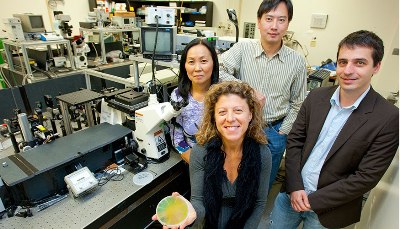Jul 31 2013
The use of plasmonic black metals could someday provide a pathway to more efficient photovoltaics (PV) -- the use of solar panels containing photovoltaic solar cells -- to improve solar energy harvesting, according to researchers at Lawrence Livermore National Laboratory (LLNL).
 LLNL engineer Tiziana Bond (center) is holding an etched silicon wafer with the nanopatterns. Second row from left to right: Bond's nanophotonics and plasmonics research team members from the LLNL Engineering Directorate Elaine Behymer, Allan Chang and Mihail Bora.
LLNL engineer Tiziana Bond (center) is holding an etched silicon wafer with the nanopatterns. Second row from left to right: Bond's nanophotonics and plasmonics research team members from the LLNL Engineering Directorate Elaine Behymer, Allan Chang and Mihail Bora.
The LLNL Materials Engineering Division (MED) research team has made breakthroughs experimenting with black metals. These nanostructured metals are designed to have low reflectivity and high absorption of visible and infrared light. The MED research team recently published their black metals research results in a cover-page article in the May issue of Applied Physics Letters titled "Plasmonic Black Metals in Resonant Nanocavities."
Authored by MED physicist and research team member Mihail Bora, the article details the work of the nanophotonics and plasmonics research team led by LLNL engineer Tiziana Bond.
It describes the team's concept of black metals, which are not classic metals but can be thought of as an extension of the black silicon concept. When silicon is treated in a certain way, such as being roughened at the nanoscale level, it traps light by multiple reflections, increasing its solar absorption. This gives the silicon a black surface that's able to better trap the full sun's wavelength spectrum.
Similarly, black metals are produced by some sort of random nanostructuring -- either in gold or silver -- without guaranteeing a full, reliable and repeatable full solar absorption. However, Bond's team developed a method to improve and control the absorption efficiency and basically turn the metals as black as they want, allowing them to increase, on demand, the absorption of a higher quantity of solar wavelengths. Her team built nanopillar structures that are trapping and absorbing all the relevant wavelengths of the entire solar spectrum.
"Our article was picked for the cover story of Applied Physics Letters because it represents cutting-edge work in the area of plasmonics, the broadband operation obtained with a clear design and its implication for the photovoltaic yield," Bond said.
This new LLNL technology could one day be used in the energy harvesting industry such as PV. By incorporating metallic nanostructures with strong coupling of incident light, broad spectral and angular coverage, the LLNL team is providing a path for more efficient photovoltaics and thermovoltaics (a form of energy collection) by means of plasmon-exciton conversion, according to Bond and Bora.
The article can be viewed at Applied Physics Letters. The teams' black metal research also will be featured in the September issue of Nature Photonics.